The Economics and Statistics Division maintains archives of previous publications for accountability purposes, but makes no updates to keep these documents current with the latest data revisions from Statistics Canada. As a result, information in older documents may not be accurate. Please exercise caution when referring to older documents. For the latest information and historical data, please contact the individual listed to the right.
<--- Return to Archive
For additional information relating to this article, please contact:
June 06, 2022EARLY LEARNING AND CHILD CARE FOR CHILDREN AGED 0 TO 5 YEARS, 2022 Statistics Canada has released data from the Survey of Early Learning and Child Care Arrangements (SELCCA) that provides a snapshot of early child care usage. The survey was conducted in early 2022 among households with children aged 0 to 5 years of age, excluding children living in institutions or on reserve. Early learning and child care arrangements include any form of child care, formal or informal, by someone other than their parent or guardian, but the survey excluded occasional babysitting and kindergarten.
The participation of children (aged 0 to 5 years) in early learning and child care varied at the provincial level with higher rates in Quebec and New Brunswick than the other provinces. In Nova Scotia, 54.5% of children were in child care (27,700 children in care). Nationally, 51.6% of children were in child care.

The participation of children (aged 0 to 5 years) in early learning and child care declined across all provinces comparing 2022 with 2019 (pre-pandemic). In Nova Scotia, the percentage of children in child care declined from 61.0% to 54.5% and nationally, this percentage declined from 59.9% to 51.6% compared with 2019.

The most common types of child care arrangement in all provinces were formal daycare, preschool or childcare centers. Care by relatives was the second most common type of child care in all provinces except Quebec, where family child care homes accounted for a larger share. Nova Scotia child care types were similar to national types with daycare/preschool (54.8%), care by relatives (30.9%), family child care home (15.7%), before/after school programs (9.9%) accounting for majority of arrangements. Smaller shares of Nova Scotia children were cared for by non-relatives in the child’s home (7.0%) or through other arrangements (2.3%).
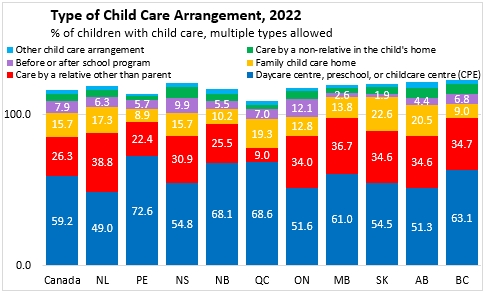
The reasons for selecting a child care arrangement were similar across the provinces. Location, trustworthy care provider, hours of operation, affordable cost, and qualifications of individual care provider were the most common response with at least one third including these as reasons for using their main child care arrangement. Affordability reasons for selecting child care were higher in Alberta and Quebec and lower in Prince Edward Island and New Brunswick. A larger share of responding parents in Manitoba and Newfoundland and Labrador selected their particular child care arrangement because it was the only option available.
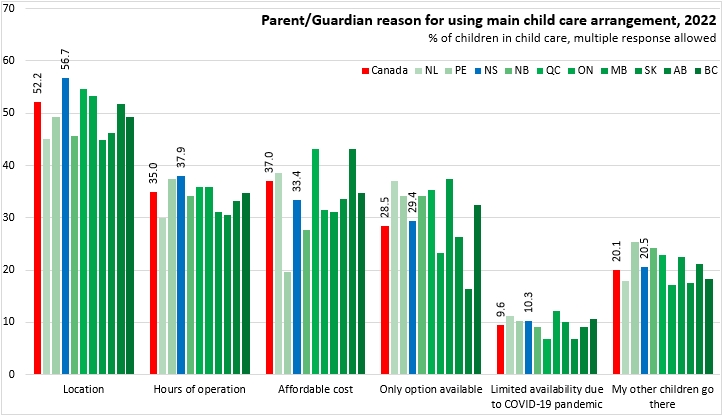
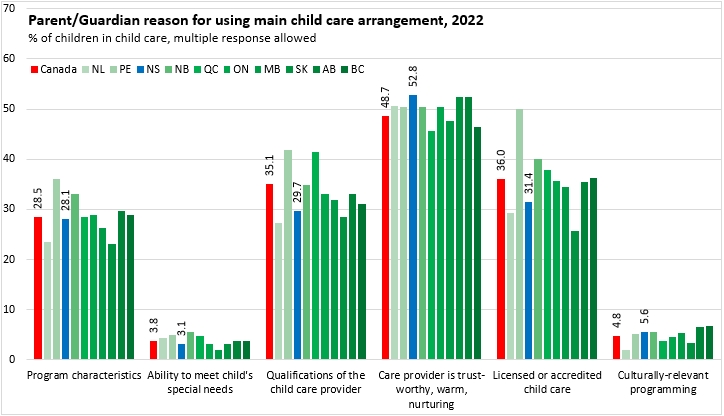
Among the respondents that have found child care arrangements in Nova Scotia, 50.7% reported no difficulty in finding child care and 44.6% had difficulty in finding child care. Having no difficulty in finding child care ranged from low of 40.1% in British Columbia to high of 60.8% in Alberta.
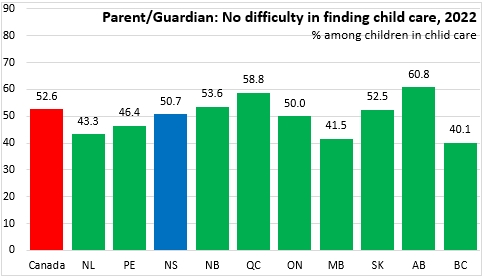
In most provinces, the most common difficulties in finding child care were related to availability in the respondent's community, affordability, fitting work/study schedules, and finding licensed care. Difficulties related to finding child’s special needs, culturally relevant programming, subsidized child care, qualified providers, and accommodating multiple children were less common. Nova Scotia respondents noted higher difficulty in finding child care within community, fitting work/study schedule, qualified provider, accommodating multiple children, and culturally relevant programing, but fewer difficulties in the other categories compared to the national respondents.
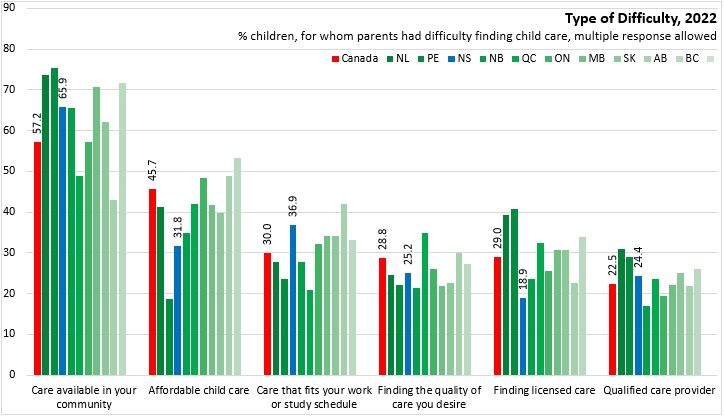

In Nova Scotia, the most common consequences related to difficulty in finding child care were multiple/temporary arrangements, working fewer hours, postponing return to work and changing work/study schedules with each category having at least 30% of respondents citing it. Deciding to have a parent stay home with a child was more prevalent among Nova Scotia parents than among those in any other province.
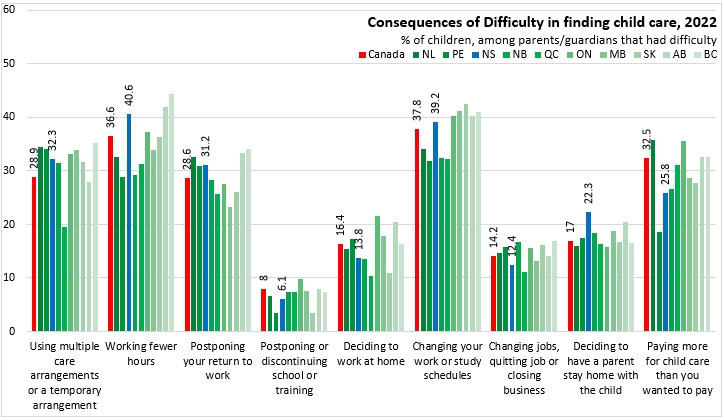
At the national level, the most common reasons for not using child care are related to a parents deciding to stay home and maternity/paternal leave followed by high costs. In Nova Scotia, high costs were reported by 27.7% of those not using child care as a reason. In Nova Scotia, 16.7% of parents were not using child care due to feeling unsafe during COVID-19 pandemic and nationally 19.9%.
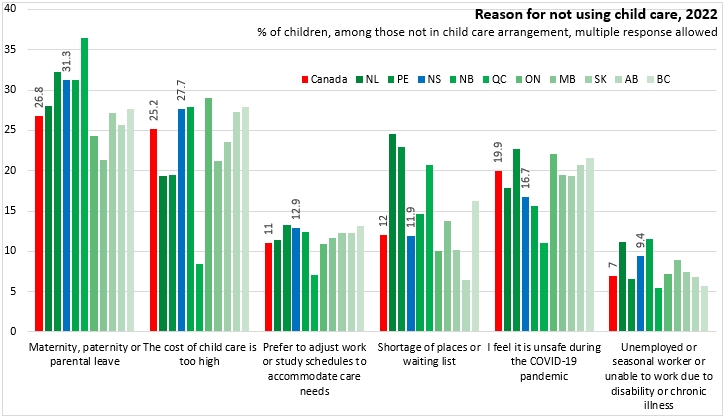
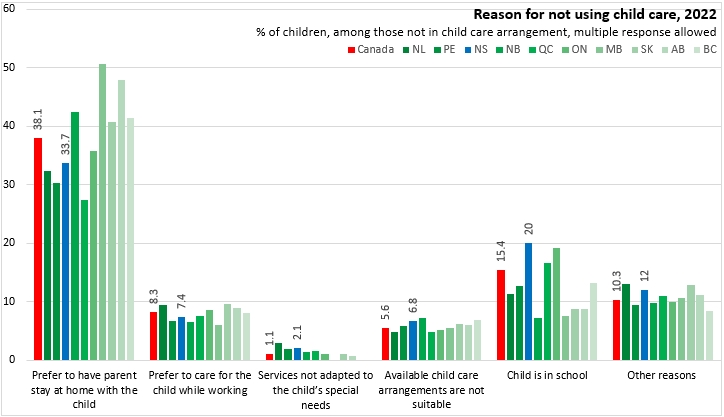
Note: Data for certain categories for some provinces is suppressed by Statistics Canada and does not show up in charts. The differences in provincial results may not be statistically significant.
Source: Survey on Early Learning and Child Care Arrangements, 2022
Statistics Canada. Table 42-10-0009-01 Consequences of having encountered difficulties in finding a child; Table 42-10-0031-01 Type of child care arrangement, children aged 0 to 5 years; Table 42-10-0010-01 Reasons for not using any child care arrangement, children aged 0 to 5 years; Table 42-10-0008-01 Type of difficulty encountered by parents and guardians in finding a child care arrangement, children aged 0 to 5 years; Table 42-10-0006-01 Parent and guardian reasons for using main child care arrangement, children aged 0 to 5 years; Table 42-10-0004-01 Use of early learning and child care arrangements, children aged 0 to 5 years; Table 42-10-0001-01 Difficulty for parents and guardians in finding a child care arrangement, children aged 0 to 5 years
<--- Return to Archive